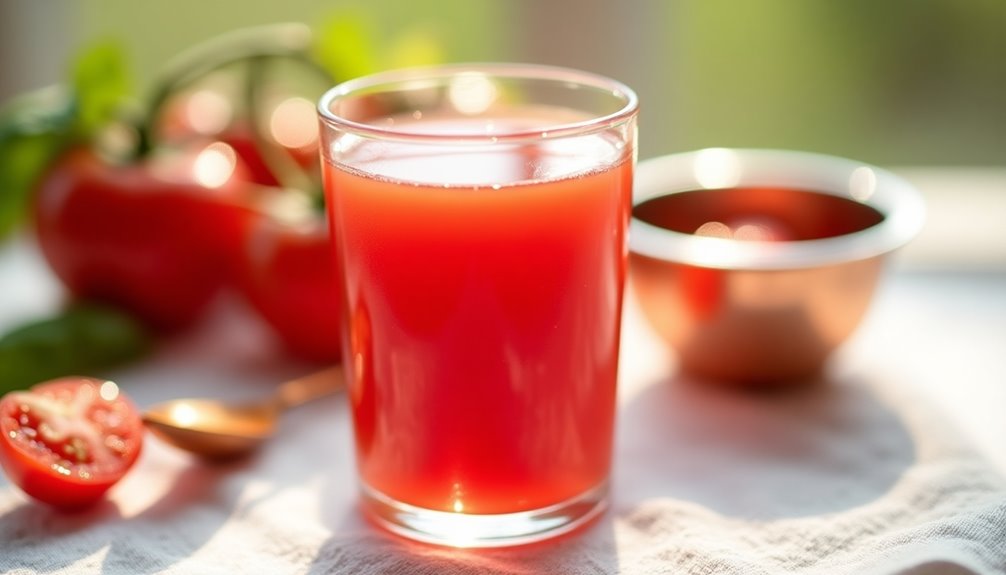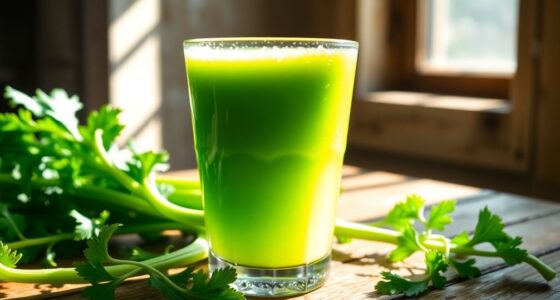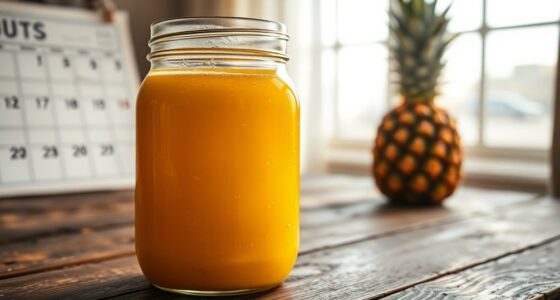To enjoy the nutritional benefits of tomato juice, aim for about one cup (240 ml) each day. This provides high levels of vitamin C and lycopene, aiding in immune function and skin health. However, watch out for sodium levels—choose low-sodium options with under 140 mg per cup. If you’re health-conscious, consider drinking it every other day to optimize absorption. There’s more to learn about how to tailor your consumption based on your unique health needs. Additionally, be mindful of the sugar content in tomato juice, as some brands can add sweeteners that increase the overall sugar levels. If you’re curious about how much sugar is in juice, it’s essential to read the nutrition labels carefully to ensure you aren’t unintentionally consuming excess sugar with your drink. Balancing your intake with whole fruits and vegetables can also enhance your overall nutrition while minimizing added sugars.
Key Takeaways
- One cup (about 240 ml) of tomato juice is generally recommended for optimal nutritional benefits.
- Choose low-sodium options with less than 140 mg of sodium per cup to maintain heart health.
- Health-conscious individuals may drink tomato juice every other day to enhance nutrient absorption and minimize gastrointestinal issues.
- Homemade tomato juice allows for control over ingredients and sodium, catering to personal dietary needs and preferences.
- Always consult a healthcare provider before starting a routine to ensure it aligns with your individual health conditions.

Have you ever wondered how much tomato juice you should drink daily to reap its health benefits? Well, you're not alone. Many people are curious about how to incorporate this flavorful beverage into their diets effectively. Generally, it's recommended to drink one cup, or about 240 ml, of tomato juice each day to fully enjoy its nutritional perks. This one cup is packed with high levels of vitamin C and lycopene, both of which are beneficial for your health.
Tomato juice is particularly praised for its high vitamin C content, which plays a vital role in immune function and skin health. Additionally, lycopene, a powerful antioxidant found in tomatoes, has been linked to reduced risks of cardiovascular disease.
However, while you might be eager to guzzle down that cup, it's essential to consider your overall sodium intake. Many store-bought tomato juices can be high in sodium, which can lead to health risks, especially for those with hypertension or heart issues. To avoid this, opt for low-sodium tomato juice, aiming for options with less than 140 mg of sodium per cup.
If you're health-conscious or have specific dietary restrictions, it might be wise to consume tomato juice every other day instead of daily. This approach can help optimize nutrient absorption and minimize any potential gastrointestinal effects associated with high tomato juice consumption. It's all about finding the right balance for your body.
You might also explore making homemade tomato juice, allowing you to control the ingredients and sodium levels. By crafting your juice, you could enhance its health benefits even further while ensuring it aligns with your dietary needs. Plus, making your juice can be a fun and rewarding experience!
Before diving into a daily tomato juice routine, it's crucial to consult your healthcare provider. They can help you determine the appropriate amount based on your unique health needs and conditions. Individual factors like age, existing health conditions, and overall dietary habits can influence how much tomato juice is right for you.
Frequently Asked Questions
What Is the Best Time of Day to Drink Tomato Juice?
The best time to drink tomato juice really depends on your goals.
If you're looking for a refreshing start, mornings are perfect. Enjoy it before meals to feel fuller and help manage your weight.
Mid-afternoon's also great for a nutritious energy boost.
Just be cautious at night if you're prone to acid reflux, as its acidity might cause discomfort.
Pairing it with healthy fats can enhance its nutritional benefits too!
How Much Tomato Juice Can I Have in a Day?
Did you know that consuming just one cup of low-sodium tomato juice daily can provide you with about 20% of your daily vitamin C needs?
When it comes to how much you can drink in a day, sticking to around one cup (240 ml) is generally recommended. This amount helps you reap the nutritional benefits without risking excessive sodium intake.
If you're unsure, consulting a healthcare provider for personalized advice is always a good idea.
Is It Safe to Drink Tomato Juice Daily?
Yes, it's generally safe for you to drink tomato juice daily, especially if you choose low-sodium options.
You'll benefit from essential vitamins like C and A, which support your health.
However, moderation is key; drinking it every other day can help optimize nutrient absorption and reduce any potential digestive discomfort.
If you have certain health issues, like GERD, you might want to limit your intake due to its acidity.
Is Tomato Juice Good for the Kidneys?
Imagine sipping a vibrant glass of tomato juice, its rich red hue promising health benefits.
Tomato juice can be good for your kidneys, thanks to its antioxidants like lycopene, which help reduce oxidative stress.
However, if you've got kidney issues, be cautious; the potassium and sodium levels might pose risks.
Moderation is key. Always check with your healthcare provider to ensure you're making the best choice for your kidney health.
Conclusion
Incorporating tomato juice into your daily routine can be refreshing and beneficial. Aim for one to two cups a day, savoring the vibrant taste, enjoying the nutritional boost, and relishing the hydration it offers. Whether you sip it in the morning, mix it in smoothies, or enjoy it in recipes, let the rich flavor and health benefits flow through you. With each glass, you're not just quenching your thirst; you're nurturing your body and uplifting your spirit.
Cindy thoroughly researches juicing trends, techniques, and recipes to provide readers with practical advice and inspiration. Her writing style is accessible, engaging, and designed to make complex concepts easy to understand. Cindy’s dedication to promoting the advantages of juicing shines through her work, empowering readers to make positive changes in their lives through the simple act of juicing.











